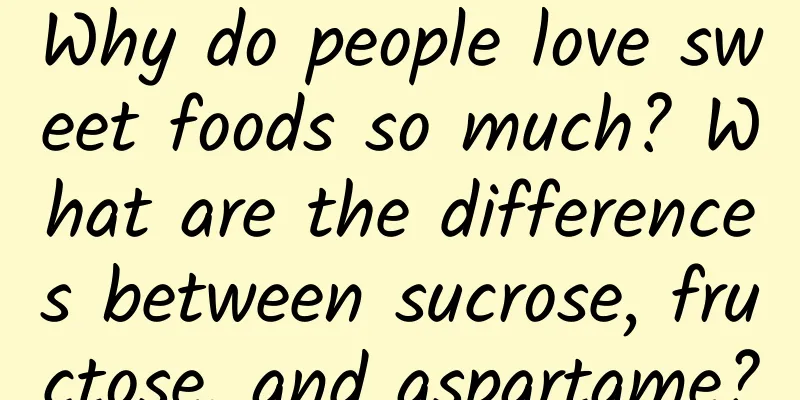Why do people love sweet foods so much? What are the differences between sucrose, fructose, and aspartame?

|
Most people find it difficult to resist the temptation of sweets, but sugar is something that makes you happy when you eat it but you will regret it after you finish eating it, because eating too much sugar will not only cause obesity, but may also lead to a series of health problems. This is actually a very strange thing. Since eating sugar is bad for health, why do humans still love to eat sugar? In fact, it is not that eating sugar is bad for health, but that we eat too much. What is sugar? Sugar is energy. It can be quickly converted into adenosine triphosphate by reacting with oxygen to replenish energy for the body. In the past millions of years, human ancestors often had to endure hunger, so sugar that can quickly replenish energy was very precious, so humans developed the habit of loving sweets. Now we no longer need to worry about food, but the habit of eating sweets is still engraved in our genes. For those of us who eat all day long, sugar intake has become a burden on the body. Since we no longer need the energy provided by sugar, the sugar we consume will be stored in the form of glycogen. However, the glycogen reserves of the human body are very limited. If we eat too much sugar, it will be converted into fat. If the fat content of the human body is too high, a series of health problems will arise. What should modern people do if they want a perfect body but cannot change their habit of eating sweets? That is to find some different "sugars" to eat. When it comes to sugar, many nouns flash through our minds, such as sucrose, fructose, lactose, maltose, aspartame, sucralose, etc. What are the differences between these "sugars"? Sugar can be roughly divided into four categories, namely monosaccharides, disaccharides, polysaccharides, and sugar substitutes. Monosaccharides are the simplest sugars, and the main representatives are glucose, fructose, and galactose. The characteristic of monosaccharides is that they are very easy to absorb. They can generate water, carbon dioxide, and adenosine triphosphate when they react with oxygen. Therefore, if you need to replenish energy quickly, monosaccharides are the best choice, which is why patients are injected with glucose. Next is disaccharide, which is formed by two monosaccharides combined together and removing a molecule of water. The main representative of disaccharides is the familiar sucrose. In addition, maltose and lactose are also common. Although the process of converting disaccharides into energy is not as direct as that of monosaccharides, it is also very easy. After entering the human body, disaccharides will first be hydrolyzed into monosaccharides and then converted into energy. For example, sucrose will be hydrolyzed into glucose and fructose, while maltose will be hydrolyzed into two units of glucose, and lactose will be hydrolyzed into glucose and galactose. Now you should understand that "no sucrose" does not mean "sugar-free". Some foods have a big "no sucrose" sign on the front of the package, and then look at the ingredient list, lactose, fructose, maltose, all included, isn't this funny? After entering the human body, these sugars are all the same. I will never buy any such product, not because there is anything wrong with the product itself, but this practice reflects that the merchant deliberately takes advantage of the consumer's lack of relevant knowledge to mislead. Merchants who like to play such tricks should not be trusted. Then there are polysaccharides, which are made up of many monosaccharides condensed, and not all polysaccharides can be converted into energy by the human body. Starch is a type of polysaccharide that can be converted into energy by the human body after hydrolysis, while another polysaccharide, cellulose, cannot be absorbed by the human body. Finally, there are sugar substitutes. Sugar substitutes are not sugar, they are just a kind of chemical substance with sweet taste. For example, the most common aspartame was not specially developed to replace sugar, but was discovered accidentally in the chemical industry production process. The sweetness of this substance is more than 200 times that of sucrose, so only a little bit is needed to make food very sweet. The calories of this little bit of aspartame are almost negligible, so it has become the most common sugar substitute. However, aspartame is not the big boss of sugar substitutes. The real big boss is sucralose, which is more than 600 times sweeter than ordinary sucrose. |
<<: Are you proud of your height of 1.8 meters? Even shorter than a Shandong green onion
Recommend
How to combine KOL to attract new members to the community?
It’s quite interesting to see a community activit...
Cold air is coming! Don’t wear your winter clothes directly from the bottom of the box, as it may cause...
Recently, cold air has hit Temperatures hit recor...
How does Kuaishou achieve commercialization?
Video applications will be our focus for some tim...
Companionship growth training camp
Companion Growth Training Camp Resource Introduct...
Entering the field of autonomous driving ProAI system, mass production will follow soon after its debut at CES
At the 2018 International Consumer Electronics Sh...
Practical Tips: How did you get 1.5 million new fans through an event?
Speaking of voting activities , it is not new at ...
B station advertising account opening, B station video promotion
It has become a reality that the vertical Z gener...
Soul-searching question: How can humans make robots "moral"?
With the rapid development of artificial intellig...
How to create word-of-mouth local life mini programs and local life service mini programs?
A few days ago, a customer consulted our company ...
Practical information: A first look at the iOS 9 Contacts framework
[[155660]] iOS 9 shows many new technologies and ...
A veteran with 5 years of operation experience shares again: practical cases of increasing followers on Zhihu!
Lao A talked to me about her experience in operat...
Should the Wenchang Tower be made of copper, crystal, or jade?
It depends on the person who needs it and what el...
Successful landing! Welcome home!
Review of this article: Pang Zhihao, Chief Scient...
Take it before or after meals? Here is a list of common medication times! Don’t be careless, save it now!
We often see instructions such as "take befo...
Design of DC power supply system for large enterprise data center (data center solution)
Large-scale enterprise-level data center DC power...









